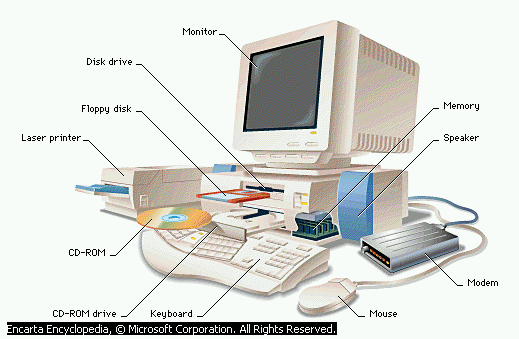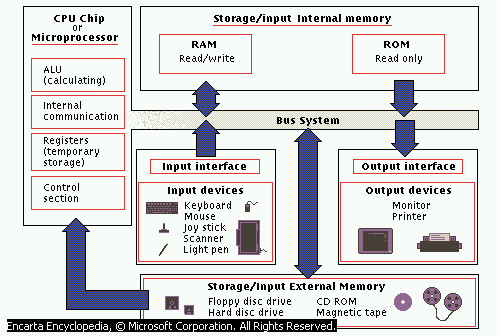
- •М.В. Жесткова, с.Я. Никитина
- •Самара 2007
- •Contents
- •Grammar review
- •To have
- •In the computer room
- •When did you decide to pursue a cs/is degree?
- •Grammar review
- •The internet
- •Computers in our life
- •Common computer applications
- •Computer applications on railways
- •Grammar review
- •What is a computer?
- •Types of computers
- •Микрокомпьютер
- •Мейнфрейм
- •Analog and digital computers
- •Grammar review
- •Hardware
- •(1) The Central Processing Unit
- •(2) Storage Devices
- •Internal Memory
- •(3) Input Devices
- •(4) Output Devices
- •The definition of mechanical brain
- •Grammar review
- •Software
- •(A) програмmное обеспечение компьютера
- •(B) популярные операционные системы windows
- •Macintosh
- •(1) Introduction
- •(2) Early Efforts
- •(3) Video Games
- •(4) Nintendo And Competitors
- •(5) Computer Games
- •(6) Advantages of Computer Games
- •(7) Popular Computer Games
- •Grammar review
- •Part I (Prehistory)
- •Part II (The Computer of the 19th Century)
- •As far as I know; In fact; It is hard to say; To my mind; In my opinion I believe; I suppose.
- •(1) Charles babbage
- •(2) Augusta ada king, countess of lovelace
- •Grammar review
- •Babbage's dream come true Part I (The Harvard Mark I)
- •Part II (colossus, eniac, edvac)
- •Computerland
- •Grammar review
- •Deep blue
- •The pc revolution Part I
- •Part III
- •People who changed the computer world Part I
- •Part II
- •Part III
- •Part IV
- •Наступление персональных компьютеров
- •Enjoy yourself
- •(2) Mother should have warned you!
- •(3) Bill gates in heaven
- •(4) 10 Programmers
- •(5) What if dr. Suess wrote a manual?
- •How modern are you?
- •Краткий грамматический справочник
- •§ 1. Личные и притяжательные местоимения Personal and Possessive Pronouns
- •§ 2. Глагол to be
- •§ 3. Глагол to have
- •§ 5. Притяжательный падеж имени существительного (Possessive Case)
- •§ 6. Существительное в функции определения (Noun as Attributive)
- •§ 7. Степени сравнения прилагательных и наречий
- •§ 8. Основные формы глагола
- •§ 9. Времена групп Indefinite, Continuous, Perfect в действительном (Active) и страдательном (Passive) залогах
- •Tenses in Active Voice
- •Tenses in Passive Voice
- •§ 10. Согласование времён (Sequence of Tenses)
- •§ 11. Модальные глаголы (Modal Verbs)
- •§ 12. Эквиваленты модальных глаголов (Equivalents of Modal Verbs)
- •§ 13. Причастие (The Participle)
- •Participle I
- •Participle II
- •§ 14. Герундий (The Gerund)
- •§ 15. Функции слов с окончанием -ing в предложении
- •§ 16. Функции слов с окончанием -ed в предложении
- •§ 17. Инфинитив (The Infinitive)
- •§ 18. Функции глагола to be
- •§ 19. Функции глагола to have
- •§ 20. Порядок слов в утвердительных предложениях
- •§ 21. Порядок слов в вопросительных предложениях
- •§ 22. Порядок слов в отрицательных предложениях
- •§ 23. Условные придаточные предложения (Conditional Sentences)
- •§ 24. Наиболее распространенные служебные слова
- •Библиографический список
Hardware
What is hardware? Webster's dictionary gives us the following definition of this word: the mechanical, magnetic, electronic and electrical devices composing a computer system. A typical personal computer (See Figure 1) has components to display and print information (monitor and laser printer); to input commands and data (keyboard and mouse); to retrieve and store information (CD-ROM and disk drives); and to communicate with other computers (modem).

Figure 1
Personal Computer Components
Computers differ greatly in their internal organization, but every digital computer has a processor and internal/external memory. All units of the computer system are linked by a bus. (See Figure 2) The bus is a flat cable with numerous parallel wires. Each wire can move one bit, so the bus can transmit many bits along the cable at a time. For example, a 16-bit bus, with 16 parallel wires, allows the simultaneous transmission of 16 bits (2 bytes) of information from one component to another.

Figure 2
Computer System
The CPU consists of an arithmetic/logic unit, registers, control section, and internal bus. The internal bus connects the units of the CPU with each other and with external components of the system. For most computers, the main input device is a keyboard. Storage devices include external floppy disc drives and internal memory boards. Output devices are monitors and printers.
(1) The Central Processing Unit
The CPU is a main part of any digital computer. In addition to performing arithmetic and logic operations on data, it coordinates and controls the activities of other units of the computer system. It determines which operations should be carried out and in what order.
The CPU is a single chip device containing millions of tiny, interconnected electrical components. Mainframe and supercomputer CPUs sometimes consist of several linked microchips, called microprocessors, each of which performs a specific task, but most other computers require only a single microprocessor as a CPU.
Most CPUs have two functional sections: the arithmetic/logic unit (ALU) and the control unit (CU).
The ALU is that part of the computer in which the four basic arithmetic operations (addition, subtraction, multiplication, division) and certain logic operations (such as the comparing of data and the selection of the required problem-solving procedure) are performed.
The CU times and regulates the whole computer system. It obtains instructions from the program stored in main memory, interprets the instructions, and transmits signals that cause other units of the system to execute them. The CU has the following components: a counter that selects and retrieves the instructions from memory; a register that temporarily holds the instructions while they are being processed; and a decoder that takes the coded instruction and breaks it down into individual commands necessary to carry it out. A very fast clock times and regulates all the operations performed by a CPU. Every tick, or cycle, of the clock causes each part of the CPU to begin its next operation and to stay synchronized with the other parts. The faster the CPU's clock, the faster the computer can perform its tasks. The clock speed is measured in hertz (Hz). Today's desktop computers have CPUs with 1 to 4 GHz (gigahertz) clocks. The fastest desktop computers therefore have CPU clocks that tick 4 billion times per second. A CPU can perform a very simple operation, such as copying a value from one register to another, in only one or two clock cycles. The most complicated operations, such as dividing one value by another, can require dozens1 of clock cycles.
T he
basic operation of the CPU is analogous to a computation carried out
by a person using an arithmetic calculator, as illustrated in Figure
3. The control unit corresponds to the human brain and the memory to
a notebook that stores the program, initial data, and intermediate
and final computational results.
he
basic operation of the CPU is analogous to a computation carried out
by a person using an arithmetic calculator, as illustrated in Figure
3. The control unit corresponds to the human brain and the memory to
a notebook that stores the program, initial data, and intermediate
and final computational results.
Figure 3
